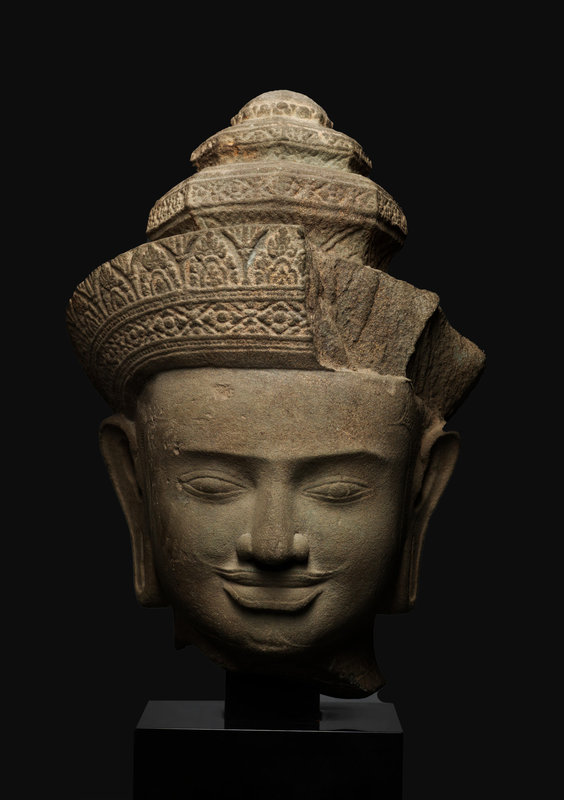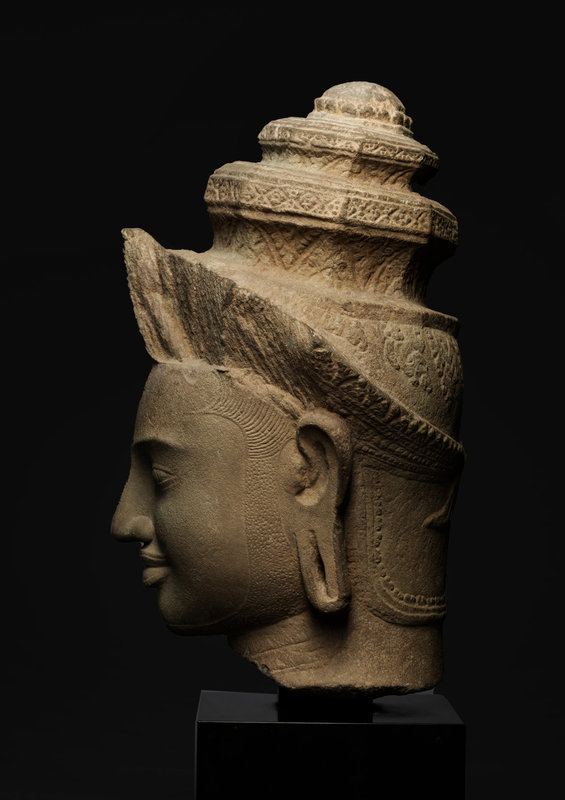A sandstone head of a male deity, Cambodia, Angkor Period, style of Pre Rup, 10th century
Lot 58. A sandstone head of a male deity, Cambodia, Angkor Period, style of Pre Rup, 10th century; 36.5cm (14 3/8in) high. (2). Sold for €75,975 (Estimate € 20,000-30,000). Photo Fabrice Gousset.
The eyebrow arches come together in a single soft line, the nostrils slightly flared, eyes defined with a delicate line and fleshy mouth with a very slight smile and faint suggestion of a moustache. Two bands of hair protrude from the diadem descending on the temples to continue with a beard defined as a dotted line, finishing in a point at the centre of the chin. The elongated earlobes are pierced and may have been adorned with cast metal pendants. The head is adorned with a royal diadem carved to imitate a real gold example that was attached at the back by ribbons tied in a square knot, stand.
Provenance: Robert Rousset, Paris (1901-1981), acquired from Capital Antique, Bangkok, 13 January 1966
Jean-Pierre Rousset, Paris (1936-2021).
Note: This larger-than-life head has a softer, more naturalistic and serene face than that of the earlier style of the Koh Kher. Pre Rup is a Hindu temple at Angkor, Cambodia, built for the Khmer king Rajendravarman (reigned 944-968) and dedicated in 961 or early 962. This powerfully carved head reflects the concept of the God-King (Deva-Raja), a system of statecraft that originated in India but was taken to new heights during the Khmer Empire (802–1437 CE). Despite being consecrated under the protection of the Hindu deity Shiva, the Khmer identified most closely with Vishnu, preserver of universal order. In fact, the deity often took on the likeness of individual Khmer rulers.
Compare with the facial features on standing Vishnu in the Los Angeles County Museum of Art (M.76.19). Also compare with a closely related head in the Minneapolis Institute of Art (69.86.1) and another in the Museum of Fine Arts, Boston (26.13). A head of similar scale with a variant to the diadem was sold at Sotheby's New York, 24 March 2011, lot 28.
Cette tête plus grande que nature présente un visage plus doux, plus naturaliste et plus serein que celui du style antérieur du Koh Kher. Le Pre Rup est un temple hindou à Angkor au Cambodge, construit pour le roi khmer Rajendravarman (règne 944-968) et consacré en 961 ou début 962. Cette tête puissamment sculptée reflète le concept du Roi-Dieu (Deva-Raja), un système de gouvernement originaire de l'Inde qui a atteint des sommets sous l'Empire khmer (802-1437 de notre ère). Bien qu'ils aient été consacrés sous la protection de la divinité hindoue Shiva, les Khmers s'identifiaient plus étroitement à Vishnu, protecteur de l'ordre universel. En effet, la divinité prenait souvent l'apparence de certains souverains khmers.
Comparer aux traits du visage de Vishnu debout du Los Angeles County Museum of Art (M.76.19). Comparé également avec une tête stylistiquement proche conservée au Minneapolis Institute of Art (69.86.1) et une autre au Musée des beaux-arts, Boston (26.13). Une tête de taille similaire avec une variante du diadème a été vendue chez Sotheby's New York, 24 mars 2011, lot 28.
Bonhams. The Robert and Jean-Pierre Rousset Collection of Asian Art: A Century of Collecting - Part 1. Paris, 25 october 2022.

/https%3A%2F%2Fprofilepics.canalblog.com%2Fprofilepics%2F1%2F0%2F100183.jpg)
/https%3A%2F%2Fstorage.canalblog.com%2F03%2F02%2F119589%2F96711876_o.jpg)
/https%3A%2F%2Fstorage.canalblog.com%2F11%2F31%2F119589%2F94773502_o.jpg)
/https%3A%2F%2Fstorage.canalblog.com%2F20%2F83%2F119589%2F94772815_o.jpg)
/https%3A%2F%2Fstorage.canalblog.com%2F26%2F72%2F119589%2F75604929_o.jpg)
/https%3A%2F%2Fstorage.canalblog.com%2F59%2F60%2F119589%2F26458628_o.jpg)








/http%3A%2F%2Fstorage.canalblog.com%2F80%2F37%2F119589%2F129777139_o.jpg)
/http%3A%2F%2Fstorage.canalblog.com%2F59%2F28%2F119589%2F129531508_o.jpg)
/http%3A%2F%2Fstorage.canalblog.com%2F39%2F44%2F119589%2F122417439_o.jpg)
/http%3A%2F%2Fstorage.canalblog.com%2F24%2F42%2F119589%2F121295195_o.jpg)